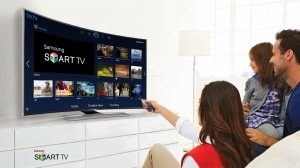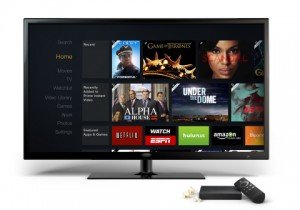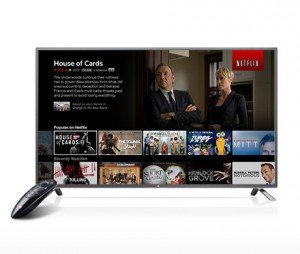 While manufacturers would really like that people start upgrading to the new Ultra HD televisions, the extremely expensive cost means that most consumers will be avoiding them for some time to come. 3D was pretty much a bust with consumers so the companies have instead hopped onto the Smart TV bandwagon. In essence, a Smart TV is any television that is connected to the internet such that it can use streaming services and potentially run applications for browsing the web, viewing photos, reading news, etc. The problem is that many people already get these features through other consumer electronics like a Blu-ray player, streaming box, video game console or even connecting a tablet through a device like Chromecast. In fact, consumers are generally better off without these features built into their TV and instead using an external device instead. After all, it could save consumers a hundred dollars or more on their next TV purchase.
While manufacturers would really like that people start upgrading to the new Ultra HD televisions, the extremely expensive cost means that most consumers will be avoiding them for some time to come. 3D was pretty much a bust with consumers so the companies have instead hopped onto the Smart TV bandwagon. In essence, a Smart TV is any television that is connected to the internet such that it can use streaming services and potentially run applications for browsing the web, viewing photos, reading news, etc. The problem is that many people already get these features through other consumer electronics like a Blu-ray player, streaming box, video game console or even connecting a tablet through a device like Chromecast. In fact, consumers are generally better off without these features built into their TV and instead using an external device instead. After all, it could save consumers a hundred dollars or more on their next TV purchase.
Limited Upgrades
All of the TV manufacturers are in a business where they are trying to sell your a TV. The ability for the device to stream media directly rather using a non-Smart TV and hooking up an external device is a selling point. Your media center will be less cluttered, everything is at your command from a single remote and of course you aren’t buying a streaming device they probably don’t make. The thing is, they want you to buy the hardware not the software. Most consumers keep their TV devices for upwards of ten years and are not looking to spend several thousand dollars every couple of years. Buying a new TV every couple of years is exactly what they would like you to be doing.
You see, updating the Smart TV features inside of the TV means that companies have to invest in the software development. If one of the streaming services adds a new feature, the TV makers would have to work with that company to try and update the software and validate it on their Smart TV units. That costs money that the companies would rather spend on putting features on a brand new TV model to try and sell consumers rather then updating a product from even a year ago. This is precisely the problem that I encountered with media connected Blu-ray players several years ago.
 Compare this to a dedicated streaming box such as Apple TV, Fire TV or the Roku. All of these streaming devices are produced by a company that is selling you hardware but is also looking to add more features and capabilities that differentiate their product from the others. They have a vested interest in updating the software and streaming capabilities for their customers. In the case of Amazon and Apple, they also make money off the potential purchases that consumers make through their services attached to the streaming devices so adding to the features helps keep the device fresh and consumers more willing to buy things through their services.
Compare this to a dedicated streaming box such as Apple TV, Fire TV or the Roku. All of these streaming devices are produced by a company that is selling you hardware but is also looking to add more features and capabilities that differentiate their product from the others. They have a vested interest in updating the software and streaming capabilities for their customers. In the case of Amazon and Apple, they also make money off the potential purchases that consumers make through their services attached to the streaming devices so adding to the features helps keep the device fresh and consumers more willing to buy things through their services.
Just Enough Performance
While the manufacturers are keen to add Smart TV features to their new TVs, they aren’t too keen on spending too much to put those features on them. The typical Smart TV uses a processor and operating system similar to most consumer tablets on the market. The thing is, they are not putting the high end processors and features that you might find even in a 2013 Nexus 7 or Amazon Kindle Fire HDX. Instead, you are seeing processors more akin to a tablet from several years ago or a sub-$100 budget tablet. They have just performance that that can stream video up to the 1080p high definition standards.
So what does this mean? If you are using it just to stream, not much as it is probably fine. But if you try to use it beyond that, you will most likely notice that it doesn’t perform even as well as a budget class tablet you can buy today. In addition to sluggish performance now, it also means that the Smart TV software is even less likely to be updated by the manufacturer because the new features can’t be supported by the limited hardware that was put into the screen.
The One Reason You Do Need a Smart TV
While I have talked about the various reasons that you probably would not want to have Smart TV capabilities in your next TV, there is one that is at least valid for now. If you are planning on getting a 4K or Ultra HD compatible TV, you will want the Smart TV capabilities. This is because there is no standard method of receiving 4K video content to your brand new screen except streaming. At this point, no broadcaster in the US is transmitting signals and cable and satellite providers don’t have the necessary bandwidth to supply the channels. The only people currently offering the content are Sony, Netflix and Amazon through their respective streaming services.I have mentioned both Netflix and Amazon which have a number of compatible streaming devices on the market that can hook up to your TV. The problem is that only a few of these devices support 4K video streams. As a result, you may need to get a smart TV in order to really take advantage of the new display technology.
Manufacturer’s Aren’t Giving You The Choice (or Costing Your More)
Sadly, most of the TV companies are now not really providing consumers with a choice of a standard HDTV or Ultra HD screen without the Smart TV features. This is especially true the larger the screen is. The reason is that the manufacturer’s consider these to be premium devices and thus pack in all the features to help get a bit more profit. The problem is that this feature packing is trickling down to the smaller screens in the 40 to 55-inch range which are the most common size for consumers to buy. This is especially true for the name brand companies like LG, Samsung, Sharp and Sony. Even VIZIO which was considered a lower tier brand is offering fewer non-Smart TVs. With these features also comes costs. Typically the additional hardware for the Smart TV functions is around $100 or more.
It would be nice to see the major manufacturers to look beyond just producing the feature rich TVs to expand their profit margins. In many cases, consumers don’t need most of the features in the HDTVs anyways. After all, most people are not even using their HDTV with an over-the-air antennae so why not produce displays that drop this feature to help reduce the costs a bit. More and more people are going to be cutting the cord and going with streaming services sure, but overall their are still better off getting a dumb TV or monitor and using an external streaming device. It would likely be less expensive than what they are currently forced to buy and has better software updates than the so-called Smart TVs.

